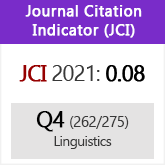Diagnostic accuracy of the Smoothed Cepstral Peak Prominence (CPPS) in the detection of dysphonia in the Spanish language
DOI:
https://doi.org/10.3989/loquens.2019.058Keywords:
acoustic voice analysis, CPPS, dysphonia, PraatAbstract
The smoothed cepstral peak prominence (CPPS) is an acoustic measure that can be calculated in both sustained vowels and continuous speech. The goal of this work is to find out the diagnostic accuracy of CPPS in the detection of dysphonia in Spanish. In this study 136 subjects with dysphonia and 47 healthy subjects participated. For each subject a sustained vowel and the reading of three phonetically balanced sentences were recorded. The CPPS was calculated with Praat using its default configuration (configuration 1), and also with the one used in the calculation of the Acoustic Voice Quality Index (configuration 2). Five experts perceptively assessed the voice of the subjects in the sample by means of the GRABS scale. The CPPS has a great power of discrimination between the normal and the pathological voice, whether it is calculated from the sustained vowel /a/ (AROC[config. 1] = 0.863 and AROC[config. 2] = 0.841) or whether it is calculated from the sentences (AROC[config. 1] = 0.884 and AROC[config. 2] = 0.866). The results confirm that CPPS is a valid acoustic measurement to detect dysphonia in the Spanish language.
Downloads
References
Awan, S. N. (2008). Instrumental analysis of phonation. En M. J. Ball, M. R. Perkins, N. Müller y S. Howard (Eds.), The handbook of clinical linguistics (p. 347). Oxford: Blackwell.
Awan, S. N., y Roy, N. (2006). Toward the development of an objective index of dysphonia severity: A four-factor acoustic model. Clinical Linguistics & Phonetics, 20, 35-49. https://doi.org/10.1080/02699200400008353 PMid:16393797
Balasubramanium, R. K., Bhat, J. S., Fahim III, S., y Raju III, R. (2011). Cepstral analysis of voice in unilateral adductor vocal fold palsy. Journal of Voice, 25(3), 326-329. https://doi.org/10.1016/j.jvoice.2009.12.010 PMid:20346619
Barsties, B., y Maryn, Y. (2015). The improvement of internal consistency of the Acoustic Voice Quality Index. American Journal of Otolaryngology, 36(5), 647-656. https://doi.org/10.1016/j.amjoto.2015.04.012 PMid:25964174
Barsties, B., y Maryn, Y. (2016). External validation of the Acoustic Voice Quality Index version 03.01 with extended representativity. Annals of Otology, Rhinology & Laryngology, 125(7), 571-583. https://doi.org/10.1177/0003489416636131 PMid:26951063
Boersma, P., y Weenink, D. (2016). Praat: Doing phonetics by computer [programa informático, versión 6.0.22]. http://www.praat.org/.
Brinca, L. F., Batista, A. P. F., Tavares, A. I., Gonçalves, I. C., y Moreno, M. L. (2014). Use of cepstral analyses for differentiating normal from dysphonic voices: A comparative study of connected speech versus sustained vowel in European Portuguese female speakers. Journal of Voice, 28, 282-286. https://doi.org/10.1016/j.jvoice.2013.10.001 PMid:24491499
Cecconello, L., Farías, P., y Gurlekian, J. A. (2008). Aplicación del cepstrum en la clínica vocal. Revista de la Federación Argentina de Sociedades de Otorrinolaringología. Edición especial, 30.º Congreso Argentino de Otorrinolaringología, 15(1), 12-14.
Dejonckere, P. H. (1998). Cepstral voice analysis: Link with perception and stroboscopy. Revue de Laryngologie, Otologie, Rhinologie (Bord), 119, 245-246.
Dejonckere, P. H., y Wieneke, G. (1996). Cepstra of normal and pathological voices in correlation with acoustic, aerodynamic and perceptual data. En M. J. Ball y M. Duckworth (Eds.), Advances in Clinical Phonetics Vol. 6. (pp. 217-226). Amsterdam: John Benjamins. https://doi.org/10.1075/sspcl.6.13dej
Delgado, J., León, N. M., Jiménez, A., e Izquierdo, L. M. (2017). Análisis acústico de la voz: medidas temporales, espectrales y cepstrales en la voz normal con el Praat en una muestra de hablantes de español. Revista de Investigación en Logopedia, 7(2), 108-127.
Delgado-Hernández, J., León-Gómez, N. M., Izquierdo-Arteaga, L. M., y Llanos-Fumero, Y. (2018). Análisis cepstral de la voz normal y patológica en adultos españoles. Medida de la prominencia del pico cepstral suavizado en vocales sostenidas versus habla conectada. Acta Otorrinolaringológica Española, 69, 134-140. https://doi.org/10.1016/j.otorri.2017.05.006 PMid:28867553
Deliyski, D. D., Shaw, H. S., y Evans, M. K. (2005). Adverse effects of environmental noise on acoustic voice quality measurements. Journal of Voice, 19(1), 15-28. https://doi.org/10.1016/j.jvoice.2004.07.003 PMid:15766847
Deliyski, D. D., Shaw, H. S., Evans, M. K., y Vesselinov, R. (2006). Regression tree approach to studying factors influencing acoustic voice analysis. Folia Phoniatrica et Logopaedica, 58, 274-288. https://doi.org/10.1159/000093184 PMid:16825780
Eadie, T. L., y Baylor, C. R. (2006). The effect of perceptual training on inexperienced listeners' judgments of dysphonic voice. Journal of Voice, 20, 527-544. https://doi.org/10.1016/j.jvoice.2005.08.007 PMid:16324823
Everitt, B. S. (2002). The Cambridge Dictionary of Statistics. 2nd ed. New York: Cambridge University Press.
Fleiss, J. L. (1971). Measuring nominal scale agreement among many raters. Psychological Bulletin, 76, 378-382. https://doi.org/10.1037/h0031619
Heman-Ackah, Y. D., Michael, D. D., Baroody, M. M., Ostrowski, R., Hillenbrand, J., Heuer, R. J., … y Staloff, R. T. (2003). Cepstral peak prominence: A more reliable measure of dysphonia. Annals of Otology, Rhinology & Laryngology, 112, 324-333. https://doi.org/10.1177/000348940311200406 PMid:12731627
Heman-Ackah, Y. D., Michael, D. D., y Goding, G. S. Jr. (2002). The relationship between cepstral peak prominence and selected parameters of dysphonia. Journal of Voice, 16, 20-27. https://doi.org/10.1016/S0892-1997(02)00067-X
Heman-Ackah, Y. D., Sataloff, R. T., Laureyns, G., Lurie, D., Michael, D. D., Heuer, R., … y Hillenbrand, J. (2014). Quantifying the cepstral peak prominence, a measure of dysphonia. Journal of Voice, 28, 783-788. https://doi.org/10.1016/j.jvoice.2014.05.005 PMid:25179777
Hernández, J. D., León-Gómez, M. L., Jiménez, A., Izquierdo, L. M., y Latoszek, B. B. v. (2018). Validation of the Acoustic Voice Quality Index Version 03.01 and the Acoustic Breathiness Index in the Spanish language. Annals of Otology, Rhinology & Laryngology, 127, 317-326. https://doi.org/10.1177/0003489418761096 PMid:29490478
Hillenbrand, J., Cleveland, R. A., y Erickson, R. L. (1994). Acoustic correlates of breathy vocal quality. Journal of Speech, Language, and Hearing Research, 37, 769-778. https://doi.org/10.1044/jshr.3704.769
Hillenbrand, J., y Houde, R. A. (1996). Acoustic correlates of breathy vocal quality: Dysphonic voices and continuous speech. Journal of Speech, Language, and Hearing Research, 39, 311-321. https://doi.org/10.1044/jshr.3902.311
Hirano, M. (1981). Psycho-acoustic evaluation of voice. En G. E. Arnold, F. Winckel y B. D. Wyke (Eds.), Disorders of Human Communication 5. Clinical Examination of Voice (pp. 81-84). Vienna: Springer.
Hochmuth, S., Brand, T., Zokoll, M. A., Zenker Castro, F., Wardenga, N., y Kollmeier, B. (2012). A Spanish matrix sentence test for assessing speech reception thresholds in noise. International Journal of Audiology, 51, 536-544. https://doi.org/10.3109/14992027.2012.670731 PMid:22537033
Kreiman, J., Gerratt, B. R., Kempster, G. B., Erman, A., y Berke, G. S. (1993). Perceptual evaluation of voice quality: Review, tutorial, and a framework for future research. Journal of Speech, Language, and Hearing Research, 36, 21-40. https://doi.org/10.1044/jshr.3601.21
Krom, G. de (1993). A cepstrum-based technique for determining a harmonics-to- noise ratio in speech signals. Journal of Speech, Langauge, and Hearing Research, 36, 254-266. https://doi.org/10.1044/jshr.3602.254
Landis, J. R., y Koch, G. G. (1977). The measurement of observer agreement for categorical data. Biometrics, 33, 159-174. https://doi.org/10.2307/2529310 PMid:843571
Latoszek, B. B., Maryn, Y., Gerrit, E., y De Bodt, M. (2017). The Acoustic Breathiness Index (ABI): A multivariate acoustic model for breathiness. Journal of Voice, 31, 511e11- 511e27. https://doi.org/10.1016/j.jvoice.2016.11.017 PMid:28087124
Maryn, Y., Corthals, P., Van Cauwenberge, P., Roy, N., y De Bodt, M. (2010). Toward improved ecological validity in the acoustic measurement of overall voice quality: Combining continuous speech and sustained vowels. Journal of Voice, 24, 540-555. https://doi.org/10.1016/j.jvoice.2008.12.014 PMid:19883993
Maryn, Y., De Bodt, M., Barsties, B., y Roy, N. (2014). The value of the Acoustic Voice Quality Index as a measure of dysphonia severity in subjects speaking different languages. European Archives of Oto-Rhino-Laryngology, 271, 1609-1619. https://doi.org/10.1007/s00405-013-2730-7 PMid:24162765
Maryn, Y., De Bodt, M., y Roy, N. (2010). The Acoustic Voice Quality Index: Toward improved treatment outcomes assessment in voice disorders. Journal of Communication Disorders, 43, 161-174. https://doi.org/10.1016/j.jcomdis.2009.12.004 PMid:20080243
Maryn, Y., Roy, N., De Bodt, M., Van Cauwenberge, P., y Corthals, P. (2009). Acoustic measurement of overall voice quality: A meta-analysis. Journal of the Acoustic Society of America, 126, 2619-2634. https://doi.org/10.1121/1.3224706 PMid:19894840
Portney, L. G., y Watkins, M. P. (2000). Foundations of clinical research: Applications to practice, 2nd ed. Upper Saddle River, NJ: Prentice Hall.
Sauder, C., Bretl, M., y Eadie, T. (2017). Predicting voice disorder status from smoothed measures of cepstral peak prominence using Praat and Analysis of Dysphonia in Speech and Voice (ADSV). Journal of Voice, 31, 557-566. https://doi.org/10.1016/j.jvoice.2017.01.006 PMid:28169094
Wolfe, V., y Martin, D. (1997). Acoustic correlates of dysphonia: Type and severity. Journal of Communication Disorders, 30, 403-415. https://doi.org/10.1016/S0021-9924(96)00112-8
Wolfe, V. I., Martin, D. P., y Palmer, C. I. (2000). Perception of dysphonic voice quality by naive listeners. Journal of Speech, Language, and Hearing Research, 43, 697-705. https://doi.org/10.1044/jslhr.4303.697 PMid:10877439
Wuyts, F. L., De Bodt, M. S., Molenberghs, G., Remacle, M., Heylen, L., Millet, B., ... y Van de Heyning, P. H. (2000). The Dysphonia Severity Index: An objective measure of vocal quality based on a multiparameter approach. Journal of Speech, Language, and Hearing Research, 43, 796-809. https://doi.org/10.1044/jslhr.4303.796 PMid:10877446
Yiu, E., Worrall, L., Longland, J., y Mitchell, C. (2000). Analysing vocal quality of connected speech using Kay's Computerized Speech Lab: a preliminary finding. Clinical Linguistics & Phonetics, 14(4), 295-305. https://doi.org/10.1080/02699200050023994
Published
How to Cite
Issue
Section
License
Copyright (c) 2019 Consejo Superior de Investigaciones Científicas (CSIC)

This work is licensed under a Creative Commons Attribution 4.0 International License.
© CSIC. Manuscripts published in both the printed and online versions of this Journal are the property of Consejo Superior de Investigaciones Científicas, and quoting this source is a requirement for any partial or full reproduction.All contents of this electronic edition, except where otherwise noted, are distributed under a “Creative Commons Attribution 4.0 International” (CC BY 4.0) License. You may read here the basic information and the legal text of the license. The indication of the CC BY 4.0 License must be expressly stated in this way when necessary.
Self-archiving in repositories, personal webpages or similar, of any version other than the published by the Editor, is not allowed.















